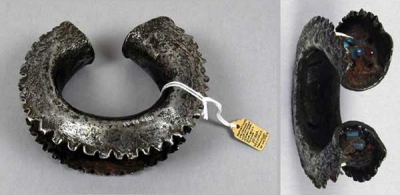Iron bracelet (1884.82.23)
 SudanIron bracelet from Sudan, Africa.Part of the Pitt Rivers Museum Founding Collection. Given to the Museum in 1884.
SudanIron bracelet from Sudan, Africa.Part of the Pitt Rivers Museum Founding Collection. Given to the Museum in 1884.
A warrior of the Murle people of Sudan or Ethiopia wore this unusual, heavy iron bracelet. It was made by cutting a row of notches along the sharpened edges of a plate of iron. The plate was then rolled longitudinally to form a half-cylinder then bent into a horseshoe shape. This example is decorated along its gutter with poisonous red abrus seeds, teeth and glass beads.
The Beautiful Warrior
Such fighting bracelets were unusual in being double-bladed. Although the Murle warrior more often fought his enemy with various types of spear, he would wear these bracelets in pairs, one on each wrist, to slash an enemy's face and back when grappling with them.
The bracelet is decorated in the gutter between the blades with a variety of glass Like several neighbouring groups, the Murle are cattle herders, and historically practised the raiding of other peoples to capture cattle and children. Most peoples of this region regarded warfare as an ongoing state of tension between themselves and their neighbours, not a state which alternated with peace, as in other parts of the world. Cattle-raiding was intended to expand one's herd, and weaken the enemy economically. Successful cattle-raiders were highly respected and admired. Murle men generally took warrior status in their twenties, retiring around the age of thirty to become village men, who were then entitled to marry and raise children, drink beer, and sit using a stool. However, men in their thirties were still expected to act as military reserves well into middle age.
The attractive denticulated edges and the gutter decoration on this bracelet - a variety of glass and red seed beads and the fangs of a jackal or wild dog set in resin - were eye-catching devices, acting to reinforce the status of its wearer. Its double-bladed form also bears a strong resemblance to those wrist-knives used historically by the renowned Hausa warriors in Nigeria, far to the west.





